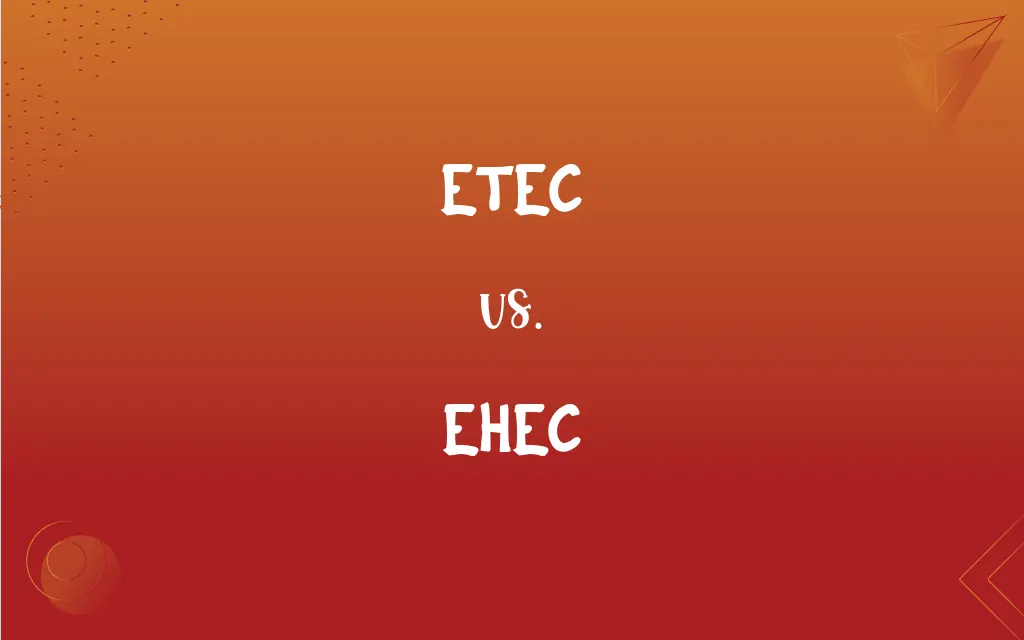ETEC vs. EHEC: What's the Difference?
Edited by Aimie Carlson || By Harlon Moss || Published on February 7, 2024
ETEC (Enterotoxigenic Escherichia coli) causes traveler's diarrhea, while EHEC (Enterohemorrhagic Escherichia coli) leads to bloody diarrhea and can cause severe kidney damage.

Key Differences
ETEC, known for causing traveler's diarrhea, operates by producing toxins leading to intestinal fluid secretion. EHEC, on the other hand, causes bloody diarrhea and can lead to hemolytic-uremic syndrome (HUS), potentially causing kidney damage.
ETEC infections are typically marked by watery diarrhea, abdominal cramps, and nausea but are usually self-limiting. EHEC infections are more severe, characterized by painful bloody diarrhea, and in severe cases, kidney failure.
ETEC is a common cause of diarrhea in low- and middle-income countries and among travelers to these areas. EHEC, particularly the O157:H7 strain, is often associated with contaminated food products in developed countries.
Treatment for ETEC generally involves hydration and antibiotics in severe cases. EHEC infections, however, require careful medical intervention due to the risk of HUS, and antibiotics may worsen the condition.
ETEC transmission is primarily through contaminated food and water. EHEC transmission is also through contaminated food, particularly undercooked meat and unpasteurized milk products.
ADVERTISEMENT
Comparison Chart
Primary Symptoms
Watery diarrhea, abdominal cramps
Bloody diarrhea, possible kidney damage
Severity of Infection
Usually mild and self-limiting
Can be severe, leading to HUS
Common Sources of Infection
Contaminated food and water in various regions
Contaminated food, especially in developed countries
Treatment
Hydration, sometimes antibiotics
Careful medical management, avoid antibiotics
Association
Traveler's diarrhea in low-income regions
Foodborne outbreaks, often in developed countries
ADVERTISEMENT
ETEC and EHEC Definitions
ETEC
ETEC transmission occurs through contaminated food and water.
Poor sanitation practices can lead to ETEC outbreaks.
EHEC
EHEC is associated with foodborne outbreaks.
Contaminated spinach was the source of an EHEC outbreak.
ETEC
ETEC is a bacteria causing traveler's diarrhea.
After drinking contaminated water, she contracted ETEC.
EHEC
EHEC requires careful medical management.
Treating EHEC involves monitoring kidney function and hydration.
ETEC
ETEC leads to intestinal fluid secretion.
The toxins released by ETEC caused severe dehydration.
EHEC
EHEC is often linked to contaminated food products.
An EHEC outbreak was traced back to undercooked hamburgers.
ETEC
ETEC infections are usually self-limiting.
The ETEC infection resolved without the need for antibiotics.
EHEC
EHEC causes bloody diarrhea and can lead to kidney damage.
The patient with EHEC was hospitalized for kidney complications.
ETEC
ETEC is common in low- and middle-income countries.
He developed ETEC symptoms while traveling in Asia.
EHEC
EHEC infection can result in hemolytic-uremic syndrome (HUS).
Children are particularly at risk of developing HUS from EHEC.
FAQs
What does ETEC stand for?
Enterotoxigenic Escherichia coli.
What are the symptoms of EHEC?
Bloody diarrhea and potential kidney damage.
How is EHEC commonly contracted?
By consuming contaminated food.
Is ETEC usually severe?
It's typically mild and self-limiting.
What is the main treatment for ETEC?
Hydration and sometimes antibiotics.
How is EHEC treated?
With careful medical management, avoiding antibiotics.
What are common symptoms of ETEC?
Watery diarrhea and abdominal cramps.
How is ETEC typically contracted?
Through contaminated food and water.
Can EHEC lead to serious complications?
Yes, like hemolytic-uremic syndrome (HUS).
What does EHEC stand for?
Enterohemorrhagic Escherichia coli.
Is ETEC contagious?
It can spread through fecal-oral contamination.
Can EHEC be fatal?
In severe cases, it can be.
Where is ETEC most common?
In low- and middle-income countries.
Where are EHEC outbreaks more common?
Often in developed countries.
What foods are commonly linked to EHEC?
Undercooked meat and unpasteurized products.
Why are antibiotics not recommended for EHEC?
They can increase the risk of HUS.
Can ETEC lead to dehydration?
Yes, due to severe diarrhea.
Is EHEC associated with kidney failure?
It can be, especially in severe cases.
Are travelers at risk of ETEC?
Yes, particularly in regions with poor sanitation.
Should antibiotics be used for ETEC?
Sometimes, in severe cases.
About Author
Written by
Harlon MossHarlon is a seasoned quality moderator and accomplished content writer for Difference Wiki. An alumnus of the prestigious University of California, he earned his degree in Computer Science. Leveraging his academic background, Harlon brings a meticulous and informed perspective to his work, ensuring content accuracy and excellence.
Edited by
Aimie CarlsonAimie Carlson, holding a master's degree in English literature, is a fervent English language enthusiast. She lends her writing talents to Difference Wiki, a prominent website that specializes in comparisons, offering readers insightful analyses that both captivate and inform.







































































